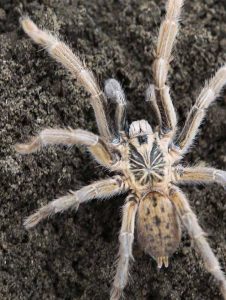The Aguacephalus Junodi is very similar to the somewhat newly discovered species Auguacephalus Ezendami, but there are differences in their locality and color. More data is needed to determine their physical differences and their genetic similarities.
While not common in the pet trade, particularly locally, the Augacephalus junodi is considered attractive because of the striking starburst pattern on their carapace and golden brown coloration contrasted with black.
Habitat: The natural habitat of the Augacephalus junodi is the dry area and savannahs of Africa. Since the natural habitat of the Augacephalus junodi is naturally dry, it is ideal to duplicate these conditions when it is in captivity.
It weaves good webs that enable them to create burrows even in sand. They are able to withstand extreme dryness of the environment and can actually survive without water as long as they are able to feed. Not all tarantulas can withstand extreme heat and dryness, and this makes the Augacephalus junodi a really hardy species to keep. In captivity, a water dish is also provided in the enclosure so the specimen is not too dehydrated even if the substrate dries up completely; this also stabilizes humidity in the enclosure.

Breeding: The breeding age for the Golden baboon tarantula is usually around 1-2 years of age. Males mature earlier than females, and maturity for the male or ultimate molt can even occur earlier.
Females will lay egg sacs; each of these can contain about 20-80 eggs that will eventually become spiderlings after the “eggs with legs” stage. A female can lay up to 2 egg sacs after a single mating as long as she does not molt after laying the first one and keeps the male’s sperm stored until the next eggs are ready to be fertilized. Spiderlings begin feeding after their second molt.
Conservation status: There is very little data regarding the conservation status of the Augacephalus junodi because very little research has been done on this particular species. There is insufficient data on their numbers in their natural habitat. The main purpose of collecting the Augacephalus junodi in the wild is only for the international pet trade since no other research is going on regarding this species. (Specimen credits to Ram Gloria)
Nyza Ho sat down with experienced tarantula keeper Clifford Kaw, who has Augacephalus junodi in his collection.
Q: What makes the Augacephalus junodi an interesting pet specimen for you?
A: The Augacephalus junodi is a very beautiful tarantula, especially with its golden brown color.
Q: What is the behavior of the Augacephalus junodi that makes it stand out from all other baboon species?
A: It is less aggressive than other baboon tarantulas in the invertebrate keeping hobby
Q: What characteristic of the Augacephalus junodi made you want to keep it?
A: Its color is golden brown and the size is not too small not too big, which is just right for the enclosure I have for it.
Q: Please describe the housing of the Augacephalus junodi in your collection.
A: Just plain cocopeat with a water dish and a hide that is made of clay and coco pot [a pot made of molded cocopeat; this is available in the market] for their hide.
Q: How well has the Augacephalus junodi adapted to the Philippine climate? Are there any special requirements for the Augacephalus junodi to survive locally?
A: Augacephalus junodi [adapted] easily in our country’s climate. I don’t use any other special housing for [it]; I just use a glass enclosure with cocopeat as a sbstrate and a water dish to keep the specimen hydrated without frequent misting.
Q: How well does the Augacephalus junodi grow in the Philippines? Does the local climate affect the growth of this tarantula?
A: The growth of Augacephalus junodi is the same [as that of] other baboon [tarantulas], which is actually quite fast considering their maximum size. Yes [the local climate affects their growth] but I think some of the other tarantulas are not affected by it too much and their growth rate is just based on the frequency of their feeding.

Q: Can the Augacephalus junodi be bred successfully locally?
A: Maybe, since there have been several successful breeding attempts of baboons in the Philippines, but I haven’t tried breeding the A. junodi yet.
Q: Since baboon tarantulas are often described as defensive, fast, or aggressive, please describe your own Augacephalus junodi in terms of behavior, feeding response and threat response.
A: As for me, not all baboons are aggressive because my Augacephalus junodi is not too aggressive or defensive; it just has a good feeding response. During feeding, it also does not display a threat pose or a defensive stance, so for me they are not defensive or aggressive, but they are surely very fast.
Q: Would you recommend the Augacephalus junodi as a first tarantula for an aspiring tarantula hobbyist?
A: I suggest [that] the Augacephalus junodi…be kept by experienced and beginner hobbyists because it is easy to take care of and it is a very beautiful species, though one should also be aware that they can be very fast when startled, but they are not very quick to bite.
Q: Have you ever been bitten by the Augacephalus junodi?
A: No, I have never been bitten by Augacephalus junodi.
This appeared in Animal Scene’s September 2016 issue.






